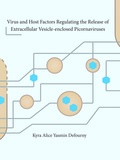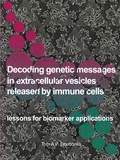Extracellular vesicles in the context of viral and bacterial infections
In the last decade we have seen an enormous rise in interest in extracellular vesicles (EVs) as means of intercellular communication. Release and uptake of EVs is a highly conserved means of communication used by cells in many organisms across the three kingdoms of life. EVs are present in in vitro (primary) cell cultures and in a multitude of body fluids. The 50-300 nm sized EVs contain lipids, (membrane-bound) proteins, and nucleic acids. EVs have been implicated in several diseases, including immune-related disorders, cancer, infection, neurological disorders and cardiovascular diseases.
Our group studies EV-biology in the context of virus- and microbial infections.
In this research we learn about the role of EVs in host-pathogen relationships. At the same time, we can use pathogens that interfere in EV biogenesis to learn about host mechanisms underlying EV formation and function. Our main research line focuses on non-enveloped (naked) viruses, mainly those belonging to the family Picornaviridae. These naked viruses can escape intact cells via enclosure in EVs. Inside these EVs, virions can stay under the radar of the host’s immune system. We study how these EV-enclosed viruses are formed and how.
The picornavirus-induced EVs affect virus spreading and the antiviral immune response. Besides virus-induced EVs, we also started a new research line on EVs released by bacteria and how these EVs interact with epithelial barriers.
In addition, our group develops novel methodologies, e.g. with omics and imaging technologies, to characterize EVs and to assess their functional properties.
Are you interested in an internship to experience the research we do in one of the above research lines? Send your CV and motivation letter to Esther Nolte-‘t Hoen (e.n.m.nolte@uu.nl)










